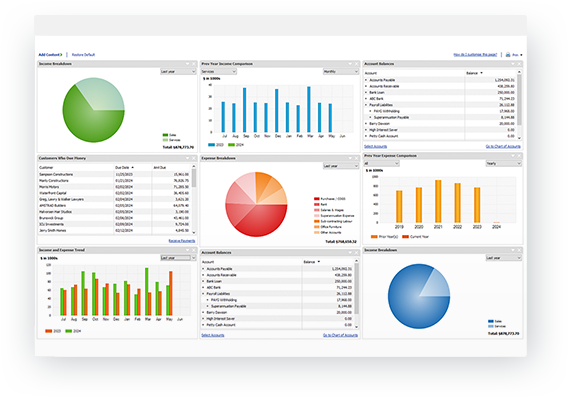Home and Business
Personal and business finances managed in the one solution.

Know exactly where your money is going.
Understand where money goes and where you can cut back. Create budgets and track where your money is being spent, so you can spend & save even smarter.


Monitor your investment portfolio
Understand exactly how your investments are performing including daily price downloads from Amazon Web Services. See how each investment fits into your overall financial plan, and easily compare investments against each other.
Plan for your future
Save and plan for your future. Make sure you have enough to spend today and will have built enough to spend tomorrow – based on your life goals. It’s cash flow management for your personal life.


Track and report on GST
Great tax features ease the pain of tax time. Items can be automatically categorised in line with ATO ‘Tax Pack’ to help you prepare your tax returns.
Create invoices and estimate
Easily create invoices and estimates and send to your customers via email. You can even customise the invoice or add a personalised message to individual invoices.

Pricing
ACCOUNTS PERSONAL HOME AND BUSINESS
$270 annually
Report on money in and out
Create and manage budgets
Monitor investments
Superannuation tracking
Customisable reports
Reconcile accounts
Handles multiple currencies
Track and report GST
Track projects & jobs
Create invoices and estimates
† Features available in Australia only
^ The Reckon Tools ANZ Share Investing service and Reckon Tools HUBB Investor software, are provided respectively by Share Investing Limited (ABN 93 078 174 973, AFSL No.238277) and HUBB Financial Group under agreement. Both are subject to their respective end user licence agreements. The ASX share download service is available for two years from date of software activation and is delivered via an arrangement between Reckon Ltd and the Australian Stock Exchange Limited, and Reckon Ltd and the NZX Ltd. If this service is discontinued then downloading portfolio details and trade details will no longer be possible. For annual licences, the ASX share download service is available for one year from date of software activation.
Windows and Microsoft are trademarks of Microsoft Corporation.
Frequently asked questions
What are the system requirements?
- IBM or compatible Pentium® II 300 (Pentium III 450 recommended) with 512 MB RAM
- Microsoft® Windows 7/8/8.1/10/10 anniversary edition*
- Compatible with Microsoft Office® 2007/2010/2013/2016
- 185 MB of disk space for Reckon Accounts installation
- DVD drive or internet connection for download
- All online features/services require high speed Internet connection
*Windows 64 bit only supported on Windows 7/8/8.1/10/10 anniversary edition. Windows 7/8/8.1/10 anniversary edition requires minimum 1 GB RAM (32Bit) or 2GB (64bit). Reckon recommends you install the latest service packs for Windows and Internet Explorer
Where can I order Reckon Accounts Personal?
How will I receive my software?
When you purchase a product on eStore, you will be provided with your licence key and a link to download the software as soon as you complete your purchase.
Do you offer training for the Personal range?
Reckon Accredited Partners, who are Reckon Personal experts, can assist with training.
Try Reckon Accounts Home and Business today!
Get your personal and business finances in order and start achieving your goals.
